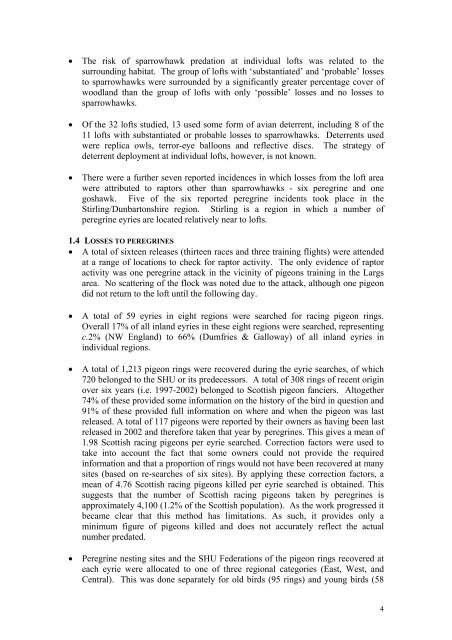RACING PIGEONS â IMPACT OF RAPTOR PREDATION
RACING PIGEONS â IMPACT OF RAPTOR PREDATION
RACING PIGEONS â IMPACT OF RAPTOR PREDATION
Create successful ePaper yourself
Turn your PDF publications into a flip-book with our unique Google optimized e-Paper software.
• The risk of sparrowhawk predation at individual lofts was related to the<br />
surrounding habitat. The group of lofts with ‘substantiated’ and ‘probable’ losses<br />
to sparrowhawks were surrounded by a significantly greater percentage cover of<br />
woodland than the group of lofts with only ‘possible’ losses and no losses to<br />
sparrowhawks.<br />
• Of the 32 lofts studied, 13 used some form of avian deterrent, including 8 of the<br />
11 lofts with substantiated or probable losses to sparrowhawks. Deterrents used<br />
were replica owls, terror-eye balloons and reflective discs. The strategy of<br />
deterrent deployment at individual lofts, however, is not known.<br />
• There were a further seven reported incidences in which losses from the loft area<br />
were attributed to raptors other than sparrowhawks - six peregrine and one<br />
goshawk. Five of the six reported peregrine incidents took place in the<br />
Stirling/Dunbartonshire region. Stirling is a region in which a number of<br />
peregrine eyries are located relatively near to lofts.<br />
1.4 LOSSES TO PEREGRINES<br />
• A total of sixteen releases (thirteen races and three training flights) were attended<br />
at a range of locations to check for raptor activity. The only evidence of raptor<br />
activity was one peregrine attack in the vicinity of pigeons training in the Largs<br />
area. No scattering of the flock was noted due to the attack, although one pigeon<br />
did not return to the loft until the following day.<br />
• A total of 59 eyries in eight regions were searched for racing pigeon rings.<br />
Overall 17% of all inland eyries in these eight regions were searched, representing<br />
c.2% (NW England) to 66% (Dumfries & Galloway) of all inland eyries in<br />
individual regions.<br />
• A total of 1,213 pigeon rings were recovered during the eyrie searches, of which<br />
720 belonged to the SHU or its predecessors. A total of 308 rings of recent origin<br />
over six years (i.e. 1997-2002) belonged to Scottish pigeon fanciers. Altogether<br />
74% of these provided some information on the history of the bird in question and<br />
91% of these provided full information on where and when the pigeon was last<br />
released. A total of 117 pigeons were reported by their owners as having been last<br />
released in 2002 and therefore taken that year by peregrines. This gives a mean of<br />
1.98 Scottish racing pigeons per eyrie searched. Correction factors were used to<br />
take into account the fact that some owners could not provide the required<br />
information and that a proportion of rings would not have been recovered at many<br />
sites (based on re-searches of six sites). By applying these correction factors, a<br />
mean of 4.76 Scottish racing pigeons killed per eyrie searched is obtained. This<br />
suggests that the number of Scottish racing pigeons taken by peregrines is<br />
approximately 4,100 (1.2% of the Scottish population). As the work progressed it<br />
became clear that this method has limitations. As such, it provides only a<br />
minimum figure of pigeons killed and does not accurately reflect the actual<br />
number predated.<br />
• Peregrine nesting sites and the SHU Federations of the pigeon rings recovered at<br />
each eyrie were allocated to one of three regional categories (East, West, and<br />
Central). This was done separately for old birds (95 rings) and young birds (58<br />
4
















